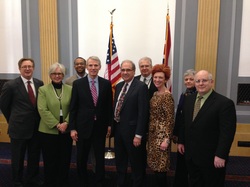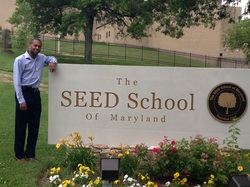 I’m currently in my second year of a two-year fellowship at the Nord Family Foundation. The purpose of the fellowship is to learn more about the field of philanthropy, serve as a program officer, and to prepare for a future in the nonprofit sector. During the week of March 3, 2014, at the persuasion of my Executive Director John Mullaney, I had the privilege of participating in my first Foundations on the Hill along with other colleagues from Philanthropy Ohio. The reason John needed to persuade me was due to skepticism I share about politics. ICYMI: There is a newly released study on how Millennials are “deeply confused” about politics. As a 26 year old, I, too, fit into this category with my generation. However, my hope is that other generations don’t view us as disinterested, politically ignorant, or that our only reference of politics is through CNN and watching House of Cards on Netflix. But rather, in this age of information, my hope is that Millennials are understood as more aware of politician hypocrisy, more understanding of the complexity of issues and less willing to think “black-and-white” on grey issues. * Stepping down from the Soap Box Before we headed to the Hill we heard passionate speeches from a number of different people representing government, foundations, nonprofits and business, but all with the same powerful message: protect and promote the charitable sector. Some of the speakers shared viewpoints that echoed some of the familiar rhetoric that many of my peers tend to tune out. But, some of the more compelling presentations came from the nonprofit organizations we partner with everyday through philanthropy that are trying to solve the world’s problems. These organizations shared their testimonies from the front line on the impact policy has on nonprofits and the damages that can be done by disincentivizing charitable giving. These latter presenters energized and further enlightened me to the importance of why we were heading to the Hill. While on the Hill I met with over 10 representatives over a two-day span but the most memorable for me was our first meeting. Our first meeting was with Republican Senator Rob Portman. Our conversation with him was very easygoing and he made it clear that he was in support of protecting the charitable sector. The conversation was almost too easy for me so after we took our photo with him and were about to head to our next meeting I stopped and asked him: “As a young man trying to decide which side of the aisle (I wanted to say Great Wall of China) to align with as I move forward in life… seeing that I am passionate about my faith and almost equally passionate about social justice, what would be your advice?” Senator Portman gave me a sincere look and said that being Republican doesn’t mean that you can’t be involved in social justice and he referenced his work on ending sex trafficking; he ended his statement by saying that the party needed more young people and diversity and asked me to follow up with him. I don’t know if his speech was inspiring enough for me to choose which side of this Great Wall of Washington I pledge allegiance to, but it definitely was thought provoking and has been on my mind. So after meeting with Senator Portman I didn’t ask any other politicians that question but I was very impressed at the number of representatives willing to hear our story. Some of our meetings were conversational and others were presentational, sometimes to stone faces. However, I had an All-Star team with me that really understood how to navigate things, break the ice and be very passionate and informative about why we were there. After it was all over someone asked me would I do it again? I most certainly would and I think there should be more foundations and nonprofits joining along with us as well. I’m looking forward to the years ahead going to Foundations on the Hill and continuing to advocate on behalf of those we serve. Here are some of my Tweetable thoughts from DC: Follow me @FrankWhitfield · @BarryDoggett knows everyone, he must live in D.C. & @ClaudiaHerrold is like the @HilaryClinton of Philanthropy. She gets things done! · Does every man in D.C. (young and old) have grey hair? #notetoself #stressincluded · @Capitol Hill hallways look like a college campus. @representativeaides = extensions of Reps. Brains. #Millennials fuel D.C.! · #Notetoself when in D.C. wear comfortable shoes #walkingincluded · Glad to be in D.C. advocating for a bi-partisan and noncontroversial topic: philanthropy. Many of the Reps. say we are the easiest conversation and a #BreathofFreshAir · @OHIO Birthday Parties are where the political deals get made! Next year @Philanthropy we need to offer something to be remembered by! Maybe free hugs in the name of “love for humanity.”
0 Comments
Left at the Door
Have you ever come into someone's home and waited at the door for instructions on what to do? Or have you ever been invited somewhere and your inviter greets you at the door and then walks away? This is what I believe is happening in our young black men we are leaving them at the door and leave them to find their way. I mean this not only in philosophical way that we are leaving them at the door of opportunity and change but also in a very practical way. I will spare you the philosophical for now and talk the practical. As a young black man I’ve walked into many rooms, and even more recently where there is little to no one who looks like me. I may recognize a face here and there that I’ve seen at another gathering but I don’t believe that there is enough of a connection to approach them for a conversation. I even sometimes was greeted by them but they left me at the door. I’m sure many of you are familiar with this feeling. It’s like being in a nightclub alone not only is the situation difficult but it also leaves you exposed and vulnerable to the wrong person. Some of us, including myself, have been guilty of even inviting young people to OUR parties, events and meetings but then “leaving them at the door.” We need to help bridge the connections even if it's a simple: “Hey come walk with me and I'll introduce you to some folks and you can hang around me tonight” Just the fact of them being introduced by you validates them and allowing them to be involved in your conversations without necessarily pressure to speak is a great opportunity to learn! That is how I learned, How I expanded my vocabulary, and How I knew what topics or words I needed to go Google when I got home Now I can hear some of you saying... “Well that's not how I learned” Well isn’t the point for us to make it easier for the next generation? To blaze a trail where we have been so that they can focus on figuring out where they are going. I can also hear the prestigious saying that “My conversations are classified and of the upmost importance!” And I understand discussing matters such as the most recent political scandal or the latest sports headline is important, but that aside we do have conversations of substance at times that could really help our young people. Not to mention keeping young people around us keeps us honest and gives a conviction to talk about REAL things. Make a vow that the next time you see a young minority alone at an event or community meeting, especially if you recognize them, you will approach them. Ask them what their name is! Ask where they’re from! Tell them to come meet some folks you know! Engage them! (which can just be them actively listening!). Let's welcome them! Embrace them! Encourage them! "It is not good for man to be alone" - Gen 2:18; "Better is a neighbor that is near than a brother far off." - Proverbs 27:10; “Though one may be overpowered, two can defend themselves.” - Ecclesiastes 4:12  On June 6, 2013. I visited the SEED Foundation’s SEED school in Baltimore Maryland. My interest in the school is rooted out of a vision I believed could help low-income young males escape poverty: boarding school education. As a low-income (which I didn’t know I was) young male, the communities and environments that most of us come from are filled with influences that are counter to what helps people get out of poverty. Some of those influences: easy access to drugs and the drug trade business, fatherless homes, working single-parent homes, violence, criminal gangs, and the ills that we hear about regularly from the streets of Chicago, IL to the streets of Lorain, OH. I learned of the Seed Model after watching the documentary “Waiting for Superman.” My eyes lit up at the thought that this idea was already being implemented and was showing success. Therefore, I knew I wanted to visit the school. So with the support of the Nord Family Foundation, I drove from Elyria, OH to Baltimore, MD with my daughter Octavia and we toured the SEED Maryland School. When I arrived I felt a similar feeling that I did upon a recent trip to Cedar Point: excited, in awe, and anxious beyond measure. I was excited about the fact I was blessed with this opportunity to see something that I dreamed of. I was in awe at the size of the campus and the sophistication of the facility including cameras and security gates. And finally I was anxious about whether I was equipped to be able to carry such a mantle and after this tour, would I feel that my dream would not become a reality? Upon entering through the trailor door into the administrative office, I was greeted by friendly staff members and then by a large yet friendly security officer. I let them know I had arrived almost 2 hours early with hopes of beating traffic, so they were deciding what they should do with me. I was content to just be witnessing the operation as I sat in the office watching the receptionist interact with each student as if it was her nieces and nephews. Finally, I was greeted by a young man who looked my age; he was the Community Outreach and Admission Coordinator Alan. He was accompanied by a SEED student DeJuan. He told me that he didn't mind showing my daughter and me around and giving us a tour while we waited for my official tour guide. As we toured the school, he greeted students and inquired of each how things were going while providing me with details of what it was like at the school. A part of why I believed in having a boarding school just for boys was because I believed that most boys in general learn different than girls and also that boys are easily distracted and that being around girls didn’t help them. I was impressed at their model of gender specific core classes for middle school student and the transition to co-ed classes once a student reached high school. I had never considered that and found that to be brilliant! Also their model of being on campus Sunday evening through Friday morning I found brilliant, because it allowed for students to be immersed in the culture on campus but yet and still keep their roots with their community. The school was full of engaged, respectful, and knowledgeable students as we toured through classrooms and talked with students. Students were taking Advanced Placement courses in the ninth grade, which could potentially lead to them attaining college credits. The school also had partnerships with local universities for their graduating class to be able to attend their colleges at no costs if they maintained a certain GPA and got accepted into the school. I also got a chance to speak with the Head of School Mr. Kirkland and with his passion and knowledge he was definitely a reflection of why the school was successful. I left the school inspired, informed, and even more driven to bring something like this to my community in Lorain County, OH . I spoke with the SEED Foundation's Director of New Schools Fundraising LouAnne about the potential of bringing something like this to my community and she mentioned that the SEED had already done a lot of groundwork in Ohio and that they would be more than interested. With my limited understanding of how charter schools work, I do understand charter management organizations and I am unsure about how receptive my community would be to having an organization outside of Ohio managing the school and we talked about the potential of the SEED Foundation consulting with a group from my community about forming its own school whether in partnership with the local school district or through the creation of a charter management organization. That is currently an ongoing discussion. But as the local school district here has just faced a recent state takeover due to academic performance I think this community is ready to try something new that has proven it works. I am scheduled to meet with our State Sen. Gayle Manning on June 26 to discuss our state policies around the urban boarding schools and about the potential of bring a SEED (or SEED-like) school to Lorain County. I am looking forward to what the future holds. To Be Continued…. After reading Roland Fryer's publications and seeing his interviews and speeches on urban education I wanted to hear his thoughts on two matters: Our local failing school which has recently been taken over by the state and to receive some guidance for my aspirations to get involved in school leadership.
In my pursuit of contacting him I was referred to speak with the Executive Director of the Harvard Education Innovation Labs June Daniel. In our hour and a half conversation filled with passion and insight she referenced a study that they conducted (see below) that found 5 fundamentals that each of the highly performing schools had: 1. A Focus on Human Capital - making sure teachers are getting immediate useful feedback from instructional coaches and administration. 2. Student Data that was used to drive instruction - Conducting regular in-depth assessments to track progress and, if needed, adjust tutoring or student goals. 3. Provided High Dosage Tutoring - whether a student is failing or excelling whether in clusters or individual sessions these schools had mandatory tutoring for all students. 4. Extended Time on Task - to make time for changes, such as tutoring, these schools had more schools days or longer schools days. 5. A culture of high expectations - students enter a school with college banners and goals of high expectations posted on the walls and they know everyone there is their to help and expects them to succeed Yes these changes may require a little more work and resources but schools like HCZ Promise Academy, KIPP, Democracy Prep and others show it is possible. So what's the hold up? Read the Report Here: Learning from Successes and Failures of Charter Schools by Roland Fryer If this is where education is going then I'm taking Thanks to Education Elements for this video. Looking forward to visiting Carpe Diem Schools soon..
Therefore, When I'm thinking about how I can have the most impact on this generation and the ones to come...
|

 RSS Feed
RSS Feed
